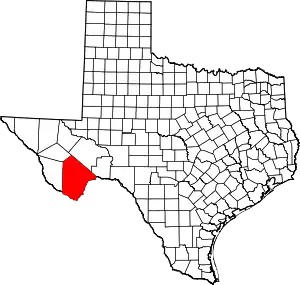Glenn Springs, Texas
Glenn Springs is an uninhabited place in the state of Texas, United States, which is of historical importance.[1] The Glenn Springs area was a natural spring providing water for Apache and Kiowa routing the Grand Indian Crossing passage at Boquillas. The Comanche tribes beseech the fresh water crossing on the Comanche Trail during their equine incursions from and to the Mexican Plateau, Sierra Madre Oriental, and the Trans-Mexican Volcanic Belt regions of Mexico.[2]
Glenn Springs, Texas | |
|---|---|
Ghost Town | |
 Topo Map of Glenn Springs, Texas | |
 Glenn Springs, Texas Location within Texas  Glenn Springs, Texas Glenn Springs, Texas (the United States) | |
| Coordinates: 29°09′40″N 103°08′51″W | |
| Country | United States |
| State | Texas |
| County | Brewster |
| Elevation | 2,447 ft (746 m) |
| Time zone | UTC-6 (Central (CST)) |
| • Summer (DST) | UTC-5 (CDT) |
| ZIP codes | 79834 |
| Area code | 432 |
| GNIS feature ID | 2034866 |
The rural settlement is located 11 miles (16 kilometers) south-southeast of the Panther Junction visitor center in what is now the Big Bend National Park, and is accessible only by high-clearance vehicle.[3] The National Park Service maintains a back-country campground at Glenn Springs.[4]
Military occupation
Glenn Springs was a military encampment, which was attacked by the troops of the Mexican General Pancho Villa on 5 May 1916, killing one civilian, three U.S. Army soldiers, and wounding several other troops.[5] The Glenn Springs Raid came 57 days after the famous attack on Columbus, New Mexico.
Wax Camp
During the Spanish Texas era, candelilla was harvested in the Chisos Mountains of the Trans-Pecos.[6] The wax plant provided a malleable solid for candles used by the Spanish missions in Texas during Franciscans orders.[7]
In 1914, W.K. Ellis and C.D. Wood established a wax factory on the embankment of Glenn Springs employing a population in the mountainous Chihuahuan Desert region. By 1916, the candelillero factory consisted of a boiler room with tall smoke stacks, six large extraction vats, and a water storage system for the production of candelilla wax.[8]
References
- Kohout, Martin Donell. "Glenn Springs, Tx". TSHA Handbook of Texas Online. Texas State Historical Association. Retrieved April 15, 2012.
- "Comanche Trail - Marathon ~ Marker Number: 994". Texas Historic Sites Atlas. Texas Historical Commission. 1936.
- National Park Service March 2000
- "Primitive Roadside Campsites — Glenn Springs". U.S. National Park Service. U.S. Department of the Interior.
- Kohout, Martin Donell. "Glenn Springs Raid". Handbook of Texas Online. Texas State Historical Association.
- Maxwell, Ross A. "Natural Uses Of Plant Life - Vegetation" [The Big Bend of The Rio Grande]. U.S. National Park Service - Texas Bureau of Economic Geology. The University of Texas at Austin. ISSN 0363-4132. OCLC 454903.
- Wright, O.M.I., Robert E. "Spanish Missions". TSHA Handbook of Texas Online. Texas State Historical Association.
- "Wax, Men, and Money: Candelilla Wax Camps along the Rio Grande". Texas Beyond History. University of Texas at Austin.
